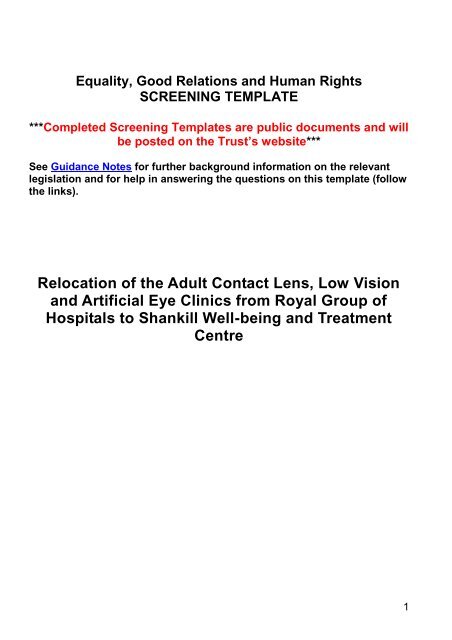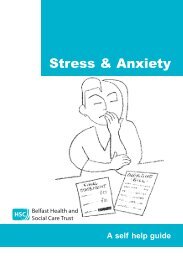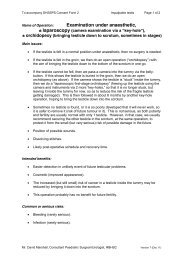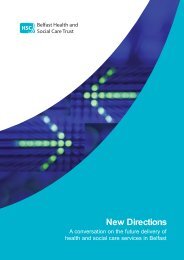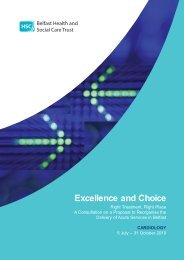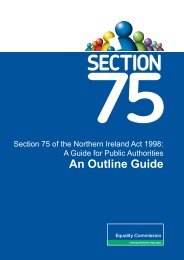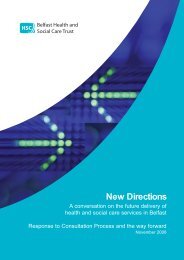Relocation of the Adult Contact Lens, Low Vision and Artificial Eye ...
Relocation of the Adult Contact Lens, Low Vision and Artificial Eye ...
Relocation of the Adult Contact Lens, Low Vision and Artificial Eye ...
- No tags were found...
Create successful ePaper yourself
Turn your PDF publications into a flip-book with our unique Google optimized e-Paper software.
Who owns <strong>and</strong> who implements <strong>the</strong> policy/proposal - where does itoriginate, for example DHSSPS, HSC Board?Belfast HSC TrustAre <strong>the</strong>re any factors that could contribute to/detract from <strong>the</strong> intendedaim/outcome <strong>of</strong> <strong>the</strong> policy/proposal/decision?Who are <strong>the</strong> internal <strong>and</strong> external stakeholders (actual or potential) that <strong>the</strong>policy/proposal/decision could impact upon? Staff; nursing, medical, optometry, technical, rehabilitation workers,administrative <strong>and</strong> clerical staff Patients Relatives Volunteers; Angel <strong>Eye</strong>s External organisations; RNIB, Guide DogsO<strong>the</strong>r policies with a bearing on this policy/proposal (for example regionalpolicies) - what are <strong>the</strong>y <strong>and</strong> who owns <strong>the</strong>m?New DirectionsThis strategic document would see <strong>the</strong> centralisation <strong>of</strong> several ophthalmologyinpatient <strong>and</strong> diagnostic services at a Regional <strong>Eye</strong> Centre at <strong>the</strong> Mater Hospitalsite <strong>and</strong> this project is to be included in phase 2 <strong>of</strong> <strong>the</strong> Strategic Services ReviewWork stream.3
2. Available evidenceUsing <strong>the</strong> evidence/information (both qualitative <strong>and</strong> quantitative) that youhave ga<strong>the</strong>red to inform this screening, please specify details/make up foreach <strong>of</strong> <strong>the</strong> Section 75 categories <strong>and</strong> for both service users <strong>and</strong> staff.CategoryDetails <strong>of</strong> evidence/informationGenderService UsersFemaleMaleService area percentagebreakdown52%48%Belfast Trustareapopulationpercentagebreakdown52.6%47.4%Age Under 1920 to 2930 to 3940 to 4950 to 5960 to 6970 to 7980 <strong>and</strong> OverReligionRoman CatholicProtestantO<strong>the</strong>r ReligionNo Religion or Nonestated12.4%13.6%15.8%13.0%4.3%8.4%13.5%19.1%The Trust does not collectthis data: -Statistics, 2001Denomination Adherents %11.8%14.4%15.9%13.0%14.0%10.6%8.9%7.2%4.3%37.4%44.7%0.6%17.3%RomanCatholicPresbyterianChurch inIrel<strong>and</strong>Church <strong>of</strong>Irel<strong>and</strong>678,462 40.2348,742 20.7257,788 15.34
EthnicityBlack AfricanBangladeshiBlack CaribbeanChineseIndianIrish TravellerPakistaniMixed EthnicityFilipinoBlack O<strong>the</strong>rWhiteNot knownDisability (NISWALD)which reported early in2007:Results from NISWALDhave found that in2006/07 18% <strong>of</strong> all peopleliving in Nor<strong>the</strong>rn Irel<strong>and</strong>have some degree <strong>of</strong>disability, The prevalencerate for adults is 21% <strong>and</strong>6% for childrenAll patients currentlyattending <strong>the</strong> clinics havea visual impairment.Service staff are culturallysensitive to <strong>the</strong> needs <strong>of</strong>people from minorityethnic backgrounds. Aninterpreting service isavailable if needed: 40,200 migrantworkers registeredin NI between April08 – March 10 2347 Births wereregistered tomo<strong>the</strong>rs bornoutside <strong>the</strong> UKSource: UK BordersAgency School attendanceby children <strong>of</strong>migrants in 2009/10: primary school5130 post primary – 2402 42 languagesspoken in NIschools7
Provide details <strong>of</strong> how you have involved stakeholders, views <strong>of</strong>colleagues, service users <strong>and</strong> staff etc when ga<strong>the</strong>ring evidence.StaffMeetings have taken place with Trade Union groups <strong>and</strong> staff affected by <strong>the</strong>proposal.Service UsersPatients attending <strong>the</strong> clinic during May 2012 were provided with a letterdetailing <strong>the</strong> proposal <strong>and</strong> seeking <strong>the</strong>ir views on how <strong>the</strong>y may be affected.several respondents expressed concerns regarding <strong>the</strong> location <strong>of</strong> <strong>the</strong> newservices <strong>and</strong> for this reason we will continue screening for adverse impact <strong>and</strong>make any changes necessary.9
3. Needs, experiences <strong>and</strong> prioritiesTaking into account <strong>the</strong> information referred to in Table above, whatare <strong>the</strong> different needs, experiences <strong>and</strong> priorities <strong>of</strong> each <strong>of</strong> <strong>the</strong>following categories, in relation to <strong>the</strong> particularpolicy/proposal/decision? Specify details for each <strong>of</strong> <strong>the</strong> Section 75categories <strong>and</strong> for both service users <strong>and</strong> staff.CategoryDetails <strong>of</strong> needs, experiences/prioritiesService UsersGender Female 52%Male 48%Age Under 1920 to 2930 to 3940 to 4950 to 5960 to 6970 to 7980 <strong>and</strong> OverReligion Please see 2.112.4%13.6%15.8%13.0%4.3%8.4%13.5%19.1%PoliticalOpinionMaritalStatusDependentStatusDisabilityPlease see 2.1Please see 2.1Please see 2.1All patients currently attending <strong>the</strong> clinics have a visualimpairment, including patients with little or no vision. Somepatients will also have co-existing disabilities such as diabetesEthnicity Please see 2.1SexualOrientationPlease see 2.110
STAFFIn <strong>the</strong> area under review <strong>the</strong>re is a higher proportion <strong>of</strong> Protestants than in <strong>the</strong>Trust as a whole but is should be remembered that <strong>the</strong> actual number involved issmall. The staff affected are predominantly female <strong>and</strong> none have indicated that<strong>the</strong>y have a disability. Not all <strong>of</strong> <strong>the</strong> staff have provided complete equalityinformation on all 9 categories. It is anticipated that <strong>the</strong>re will be no reduction instaffing levels. The Trust is satisfied that <strong>the</strong>re is no adverse impact regardingany equality category11
AgeReligionPoliticalOpinionMaritalStatusDependentStatusDisabilityEthnicitySexualOrientationPromotion <strong>of</strong> normalisation inthat <strong>the</strong> new premises willbe a neutral <strong>and</strong> welcomingenvironment for all staff <strong>and</strong>UsersPromotion <strong>of</strong> normalisation inthat <strong>the</strong> new premises willbe a neutral <strong>and</strong> welcomingenvironment for all staff <strong>and</strong>UsersThe proposed new location isfully DDA compliantperson centredNo. The policy has beendesigned <strong>and</strong> developed to beperson centredNo. The policy has beendesigned <strong>and</strong> developed to beperson centredNo. The policy has beendesigned <strong>and</strong> developed to beperson centredNo. The policy has beendesigned <strong>and</strong> developed to beperson centredNo. The policy has beendesigned <strong>and</strong> developed to beperson centred4.3 To what extent is <strong>the</strong> policy/proposal likely to impact on goodrelations between people <strong>of</strong> different religious belief, political opinion orracial group? minor/major/noneGoodrelationscategoryReligiousbeliefDetails <strong>of</strong> policy/proposalimpactLevel <strong>of</strong> impactMinor/major/none <strong>and</strong> pleaseexplain your reasonMinorPoliticalopinionRacialgroupMinorNone13
A sensitive holistic service is provided to all our users. The service is patientcentred <strong>and</strong> patient led4.4 Are <strong>the</strong>re opportunities to better promote good relations betweenpeople <strong>of</strong> different religious belief, political opinion or racial group?Good If yes, provide details If no, provide detailsrelationscategoryReligiousbeliefPoliticalopinionRacialgroupNo. The service works closelywith <strong>the</strong> relevant User support<strong>and</strong> community groups <strong>and</strong> thiswould continue.14
5. Screening decisionA full equality impact assessment (EQIA) is usually confined to thosepolicies or decisions considered to have major implications for equality <strong>of</strong>opportunity.How would you categorise <strong>the</strong> impacts <strong>of</strong> this decision or policy/proposal?(refer to guidance notes for guidance on impact)Please tick:Major impactClick here for description (inserthyperlink)EQIA Required? (Delete as appropriate)NoMinor impactClick here for description (inserthyperlink)Mitigation RequiredYes/NoAlternativePolicy RequiredYes/NoNo impactClick here for description (inserthyperlink)Screened Out5.2 Please give reasons for your decision <strong>and</strong> detail any mitigation oralternative policies considered.Any relocation <strong>of</strong> staff will be dealt with in accordance with <strong>the</strong> Framework on <strong>the</strong>Management <strong>of</strong> Staff affected by Organisational Change <strong>and</strong> <strong>the</strong> StaffRedeployment Protocol will be applied in conjunction with Trade Unions.Individual meetings took take place with affected staff in May 2012 to establish if<strong>the</strong>y wished to transfer with <strong>the</strong> service. Staff who do not wish to transfer with<strong>the</strong> service will be managed as outlined above.5.3 Do you consider <strong>the</strong> policy/proposal needs to be subjected toongoing screening? NB: for strategies/policies that are to be put inplace through a series <strong>of</strong> stages – screen at various stages duringimplementation.15
Yes√NoPlease give reasons for your decision If you have identified any impact,what mitigation have you considered to address this?. The proposedrelocation, from RVH to Shankill health <strong>and</strong> Wellbeing Centre may causeanxiety to some users. Screening will continue in terms <strong>of</strong> possible ‘chill factor’16
6. Consideration <strong>of</strong> disability dutiesIn what ways does <strong>the</strong> policy/proposal or decision encourage disabledpeople to participate in public life <strong>and</strong> what else could you do to do so?For example, have you engaged with disabled people in relation to thispolicy/proposal/proposal?How does <strong>the</strong> policy/proposal ordecision currently encouragedisabled people to participate inpublic life?What else could you do toencourage disabled people toparticipate in public life?N/AThe Shankill Wellbeing <strong>and</strong> TreatmentCentre is a fully accessible DDAcompliant building based in <strong>the</strong> centre <strong>of</strong><strong>the</strong> local community where people go toshop <strong>and</strong> access o<strong>the</strong>r services.The centre provides:Therapy services:- podiatry- physio<strong>the</strong>rapy- speech <strong>and</strong> language <strong>the</strong>rapy- occupational <strong>the</strong>rapy.Social work <strong>and</strong> nursing services:- elderly people- family <strong>and</strong> children- people with sensory impairment- people with physical disabilities.Rehabilitation servicesCare managementDental clinics.In what ways does <strong>the</strong> policy/proposal or decision promote positiveattitude towards disabled people <strong>and</strong> what else could you do to do so?17
How does <strong>the</strong> policy/proposal ordecision currently promote positiveattitudes towards disabled people?What else could you do to promotepositive attitudes towards disabledpeople?M<strong>and</strong>atory Equality Training whichincludes Disability Training is providedfor all staff. Additional DisabilityAwareness training is also available forall staff18
7. Consideration <strong>of</strong> Human RightsDoes <strong>the</strong> policy/proposal or decision affect anyone’s Human Rights?Highlight how you have considered each <strong>of</strong> <strong>the</strong> articles <strong>and</strong> if <strong>the</strong>re was anegative impact as a result <strong>of</strong> having to interfere with someone’s humanright, outline how it was necessary, fair, justifiable <strong>and</strong> proportionate.ArticleArticle 2 – Right to lifePositiveimpactNegativeimpact =human rightinterferedwith orrestrictedNeutralimpactArticle 3 – Right to freedom from torture,inhuman or degrading treatment orpunishmentArticle 4 – Right to freedom from slavery,servitude & forced or compulsory labourArticle 5 – Right to liberty & security <strong>of</strong> personArticle 6 – Right to a fair & public trial within areasonable timeArticle 7 – Right to freedom from retrospectivecriminal law & no punishment without lawArticle 8 – Right to respect for private & familylife, home <strong>and</strong> correspondence.Article 9 – Right to freedom <strong>of</strong> thought,conscience & religionArticle 10 – Right to freedom <strong>of</strong> expressionArticle 11 – Right to freedom <strong>of</strong> assembly &associationArticle 12 – Right to marry & found a familyArticle 14 – Prohibition <strong>of</strong> discrimination in <strong>the</strong>enjoyment <strong>of</strong> <strong>the</strong> convention rights1 st protocol Article 1 – Right to a peacefulenjoyment <strong>of</strong> possessions & protection <strong>of</strong>property1 st protocol Article 2 – Right <strong>of</strong> access toeducation19
Please outline any actions you will take to promote or raise awareness <strong>of</strong>human rights or to ensure compliance with <strong>the</strong> legislation in relation to <strong>the</strong>policy/proposal or decision.A Human Rights based approach is taken in <strong>the</strong> design development <strong>and</strong>provision <strong>of</strong> all Trust Services20
8. MonitoringWhat data will you collect in <strong>the</strong> future in order to monitor <strong>the</strong> effect <strong>of</strong> <strong>the</strong>policy/proposal or decision on any <strong>of</strong> <strong>the</strong> categories for equality <strong>of</strong>opportunity <strong>and</strong> good relations, disability duties <strong>and</strong> human rights?Equality & GoodRelationsPatient <strong>and</strong> StafffeedbackComplaints <strong>and</strong>compliments – thisinformation will beforwarded to <strong>the</strong> Health<strong>and</strong> Social InequalitiesTeamDisability DutiesPatient <strong>and</strong> Stafffeedback on access toserviceComplaints <strong>and</strong>compliments – thisinformation will beforwarded to <strong>the</strong> Health<strong>and</strong> Social InequalitiesTeamHuman RightsPatient <strong>and</strong> StafffeedbackComplaints <strong>and</strong>compliments – thisinformation will beforwarded to <strong>the</strong> Health<strong>and</strong> Social InequalitiesTeam DNA rates / referral rates / waiting lists. Complaints Feedback from staff /users– which will be reported to <strong>the</strong> Health <strong>and</strong> SocialInequalities Team annually for two years.Approved Lead Officer:Position:Stephen BoydService ManagerDate: 1 July 2012Policy/proposal screened by: Maureen Doyle, Equality Manager,Miriam Gibson EmploymentEquality Manager25 th July 2012Please forward completed screening template to <strong>the</strong> Health <strong>and</strong> SocialInequalities team21


